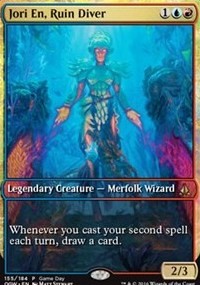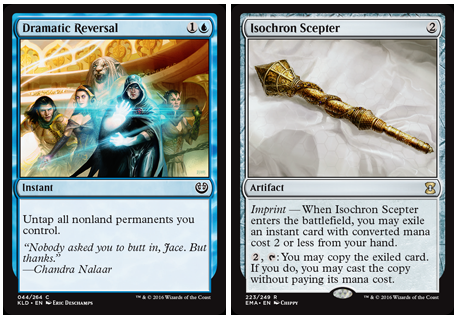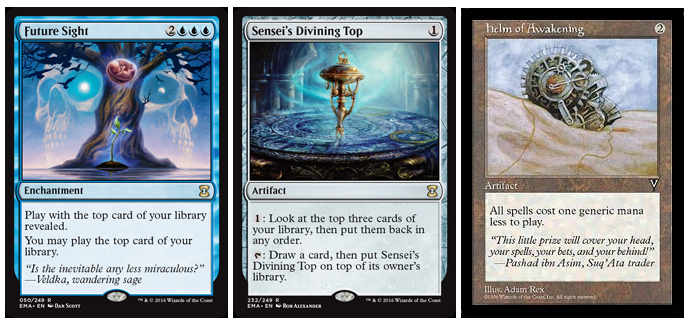Jori En - A Primer
This primer is also posted to my friend's blog. You can find it here.
Storm is fun. For the pilot. This is a constant in all formats in which storm is viable, which is most of them. Better players than I have demonstrated exactly how true this is in Commander, with lists like this one. While all-in Grixis Storm decks may be the most viable way to win with a high storm count, they have some inherent problems for anyone playing outside a hardcore competitive metagame. Specifically:
- Maintaining a three-color manabase in an archetype reliant on High Tide is not cheap, and can be inconsistent.
- They can be incredibly intimidating, and immediately become the threat at the table.
- They don't play nice with others.
That last point is key. While there is a decent amount of interaction in Jeleva Storm and similar, most lists aren't designed for the long game, and don't have a comfortable plan outside of storming off. This is a huge deal, because there are absolutely tables at which an early storm kill is the least fun thing to have happen. So what can you do? Just not play storm unless your meta is purely competitive? I'm here to present another option: play storm in a combo-control shell.
The theory behind this is pretty simple. The deck has two stances: aggressively play for the combo turn, or be the control player. Why does this matter? Well, the main problem storm has is the raw time it takes to resolve the winning turn. If you're winning turns 3-5, and most of the early turns are land-go, you've just dominated the total time taken by all players with a five minute turn in a ten minute game. Do this an hour in, after controlling the board and keeping a few other players from winning, and this doesn't seem quite as bad.
Of course, I can't guarantee that this won't still give people the feel-bads. Storm is not something everyone enjoys playing against, and for some people, the mere fact that it is your win condition will be enough for them to hate you and everything you represent. Unfortunately, this seems to be true of practically any deck one could play, so I'll just be moving on.
Okay, so now we just need to figure out how to play control and combo with the same deck. To be honest, the control part on its own is not an easy task. In a four-player game, the only real types of controlling interaction that scale well are stax and board wipes. Stax is probably going to interfere with our storm plan, and board wipes can be dead or ineffectual against a variety of types of decks, so we will have to rely on traditional countermagic and spot removal as well. Both of these scale... poorly. Holding down an entire table is incredibly difficult. We need a commander that can recoup some of the advantage lost from spending our cards defensively. My weapon of choice: Jori En, Ruin Diver.

Jori is unassuming. She'll generally draw you a card per round, sometimes two, and occassionally none. The interesting thing here is that as you try to control the table, she'll often be drawing cards in proportion to the number of threats that must be dealt with. Every time you interact on an opponent's turn, you have an opportunity to spin it into card advantage. This can actually be enough to tip the scales to where controlling three players is possible. The other key points Jori hits: she is not necessary for the storm plan, so casting her is usually not seen as threating; and she has relatively low mana cost, allowing her to be played while players are still developing.
Jori isn't exactly conventional, so let's compare her briefly to the other options.
Alternative Commanders
Mono Blue
Baral, Chief of Compliance and Jace, Vryn's Prodigy are both fairly viable for this archetype. Each filters your draws in some way, getting you to the card advantage needed to control the board, and each contributes to the storm plan (Baral by being a cost reducer, Jace by flashing back a critical spell, often High Tide). That said, they don't directly contribute card advantage, and being mono blue removes Past in Flames and Yawgmoth's Will as options, cutting some resilience from the storm plan.
Blue/Black
Dralnu, Lich Lord presents an interesting twist on Jace, but the high mana cost and harsh risk make this option unappealing.
Oona, Queen of the Fae is an infinite mana outlet in the command zone. Aaaand... That's it. For the archetype we are playing, a commander who is only useful when you are ready to win is not a great commander.
Blue/Red
Keranos, God of Storms provides some of the same goodness as Jori, by either drawing a card or controlling the board each turn. Unfortunately, at five mana, the benefits Keranos provides are not sufficient. The majority of the time, this is a lightning bolt once per turn, which is just not enough.
Mizzix of the Izmagnus, and to a lesser extent Melek, Izzet Paragon and Niv-Mizzet, the Firemind, can be powerful commanders, with abilities that contribute directly towards the storm turn. Unfortunately for the latter, they cost six mana, and unfortunately for Mizzix, he is very much a known quantity. Mizzix is incredibly dangerous to leave in play, and as a result, he dies. A lot. Further, Mizzix is highly build-around, so if he is not in play, the deck becomes significantly worse. This is just not what we're looking for.
Nin, the Pain Artist is probably the closest to Jori En, and it would not be unreasonable to run her. At worst, she's a slow Braingeyser, but when you have other creatures in play, she is repeatable instant speed card draw. Even better, she's an outlet for infinite mana, and can act as spot removal in an emergency.
Decklist
Let's assume you accept that Jori En is a viable commander for a control/storm deck. Let's take a look at such a deck.Win Conditions
Ultimately, almost every win this deck gets will be through Aetherflux Reservoir. This card makes achieving lethal storm far easier than cards with the actual storm mechanic. This win condition, and to a lesser extent Grapeshot, is supported by two combos, both relatively well-known at this point.

Imprinting Dramatic Reversal on Isochron Scepter with mana rocks gives you arbitrarily large storm, and with mana rocks producing three or more total, infinite mana. Though this does not win the game on its own, in many circumstances, it is easy to transition this into a win.

Having Helm of Awakening, Future Sight, and Sensei's Divining Top in play will allow you to repeatedly activate top and recast it for free, effectively drawing your deck and building a massive storm count.
Everything else
I'm going to break down most of the deck into several categories.
CounterspellsThe countermagic suite includes cards that fulfill at least one of the following requirements:
Keeping roughly to these guidelines lets us split the difference between storm and control. Mana efficient can often mean that Jori En draws more cards, and that velocity is super important. |
RemovalThe exact mix of removal spells is something I'm constantly messing with, but here's some examples:
Since it's rare to get removal mixed into card draw in these colors, I focus on extreme mana efficiency for Jori, with the exception of the more flexible answers in these colors. |
Draw/FilteringThere has to be a lot of this, to smooth the divide between combo and control.
These serve drastically different purposes depending upon the circumstance. Cantrips allow Jori En to consistently build card advantage cheaply or velocity when looking for a combo, while deeper digging spells search for either answers or fuel for the storm turn. |
StormThese cards are primarily useful as setup, fuel, or payoff for the storm turn. As always, there is some overlap (in fact, the more useful these cards are elsewhere, the better). The win conditions already listed above are omitted.
You may notice that the cards dedicated just to the storm turn are few. This is intentional. There is enough draw and filtering to find them when the time is right, and the majority of the list should be flexible enough to be useful both when looking to combo and when just kicking back. |
RampBoth forms of ramp are essential to this deck. Cost reducers lead to turns similar to the modern Past in Flames deck, and turn certain spells mana-positive. Besides the general need to get ahead on mana common to all EDH decks, running the Reversal/Scepter win condition requires some dedication to mana rocks.
|
LandsFirst thing first: High Tide is a good card, and to use it we need islands. Second, we intend to be relying on not "whiffing" during the storm turn, which can be caused by drawing too many lands with wheel effects and other card draw. As such, we want a low land count. The high density of cantrips and the engine Jori En provides somewhat compensates for this. Everything else should consistently provide two colors and arrive untapped, with the possible exceptions of Izzet Boilerworks (which works very well with untap effects) and at most one basic Mountain. My current list looks something like this: 20x Islands (including shocks and fetches) 8x UR Lands 1x Bounce Land 1x Mountain |
Reading the Table
With the list established, it's time to talk about what I consider the most important part of playing this deck: figuring out what your opponents want. There are players who want to play against the best you have, and others that would rather the game go long and everyone get a chance to play. As the pilot of this deck, you have the opportunity to give both types of players what they want. Figuring out what's going on at your table is essential to having a good game of EDH for everyone, and it's worth going into some of the subtleties.
Commanders
As anyone who has played against multiple opponents knows, the commanders your opponents choose can either be highly indicative or highly misleading. Take the information you have, but don't make hard assumptions. Certain commanders, like Jace, Teferi, and Zur, can be strong pointers that your opponents are trying to win. Others are more ambiguous, like Breya, Jeleva, and Animar, each of which have viable competitive builds and casual fun modes. Still others are indicators that your opponents aren't trying to optimize to win, like Norin, Kynaios and Tiro, or Kangee (sorry man).
In short, the information you get on turn 0 is the first clue as to what you should be doing. If this isn't enough information, you'll have to move on to the next indicators.
Talking
I know, crazy, right? Full disclosure, I'm generally against fishing for information in a tournament setting, but this isn't quite the same. Everyone's here to have a good time, and it's in everyone's interest that players be on the same page. If the guy across from you shows you General Tazri, allow yourself to show some natural fear that this may be Food Chain Tazri, and you'll be dead on turn 4 (you won't be, most likely, we have a lot of interaction to prevent that sort of thing). You may get a response along the lines of "Don't worry, I don't play combos," or "Haha yeah," and you can feel free to treat them appropriately.
By the same token, if someone asks you what you're doing, don't lie. Honesty in your expectations for how the game will be played is the best way to get the game everyone wants.
Card Choices
If all else fails, the cards don't lie. From the overt (Mana Crypt, ABUR duals, revealed combo pieces) to the more subtle (cards like Preordain are often overlooked by new players in favor of splashier effects), it should be possible in the first 2-3 turns to figure out roughly what people's decks are like.
When Not to Win
Okay, look, I know this sounds bad. I don't at all mean to say that this deck is super competitive and has to shoot itself in the foot in order to not utterly overpower your local scrubs, because that is absolutely not the case. What I mean is that there are ways in which you can win that result in only you having fun, and if you're like me, that probably means you aren't having fun either. As you play the deck more, you'll start seeing windows to go infinite relatively fast, because it turns out Dramatic/Scepter is pretty good. Don't do this if you don't think the table would be okay with it. By the time you have the opportunity to go for it, you should have an idea whether people are playing fair or not. Ending the game suddenly, especially if most of what the other players expect from a game hasn't happened yet, will likely not make you many friends.
What I've found is that a natural storm turn can actually be more interesting to less competitive players than an easy combo. This is especially true late game, when a couple other players have already tried to push their advantage. As mentioned above, this isn't always true, but it's something to consider. The most important thing to remember here is your time. Play fast. Make mistakes. Apologize for taking time, if you have to think for more than a few seconds. You'll get better at the deck and mess up less eventually, but until then, don't waste everyone's time by trying to optimize your every move.
This leads to the most important thing to remember. It's okay to lose. It's even okay to lose if you could have won. Unless everyone's showing up to the table with the explicit intent to compete to the best of their ability, you have nothing to prove. Against non-competitive tables, racing to the kill is like trying to win a figure skating contest by speed skating.
Budget Concessions
As with Grenzo, this is not a fully optimized list. Obvious additions given a higher budget include Volcanic Island, fetches, Mana Crypt, and Wheel of Fortune (though Reforge the Soul does have interesting synergy with Jori En). Other more marginal omissions include Ancient Tomb, Jace, Vryn's Prodigy, and Jace, the Mind Sculptor.Wrapping Up
TL;DR: It is possible to play storm at tables where nobody wants storm and come out not looking like a jerk. I think this is a pretty good way to do that.
Thanks for reading, folks. If you enjoyed this, consider checking out my youtube channel 1600 Horsepower.
